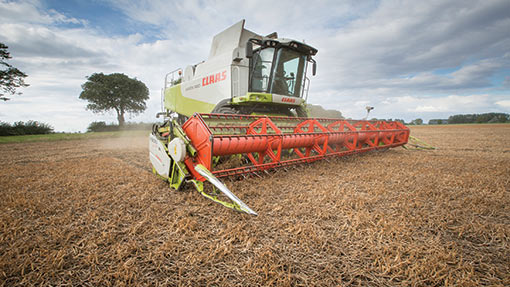How to plan cropping under new ‘greening’ rules

The rules on “greening”‘ are yet to be clarified by Defra, the Rural Payments Agency and Natural England, so growers around the country are having to make cropping decisions with a degree of guesswork.
Nick Fone talks to four from Wiltshire to Northumberland who have stuck their necks on the line.
Tom Bradshaw, Essex
 With no definitive guidelines on just what will be expected of growers to qualify for the new greening rules, Essex contract farmer Tom Bradshaw has had to make certain assumptions to ensure he is prepared for whatever may come from Defra.
With no definitive guidelines on just what will be expected of growers to qualify for the new greening rules, Essex contract farmer Tom Bradshaw has had to make certain assumptions to ensure he is prepared for whatever may come from Defra.
“The picture is still so unclear as to the exact requirements but we’d be stupid to sit still and wait – we need to plan our rotations well in advance,” he explains.
“Several of our contract farms already have three crops so we shouldn’t have a problem there. However one 320ha unit only has two crops this year. The real issue will be with the smaller contract farms, which we generally try and block crop.
FARM FACTS: ProAgri, Essex
Current cropping:
- Winter wheat – 791ha
- Oilseed rape – 350ha
- Winter barley – 107ha
- Peas – 107ha
- Spring beans – 86ha
- Spring barley – 55ha
- Sugar beet – 18ha
- Grass/ELS – 76ha
“We have one 16ha farm that will in theory have to have two crops, but it will be a logistical nightmare. I imagine we’ll end up sticking with one main crop for the lion’s share and leaving the required remainder fallow.”
The majority of his 1,590ha arable area stretching across seven holdings already complies with the new rules, with a combination of winter and spring wheat, spring barley, oilseed rape, beans and peas.
“We’ve already got plenty of legumes in the mix so it shouldn’t be too much drama to achieve the required acreages of N-fixing crops to qualify for our Ecological Focus Area [EFA].
“In previous dry years we’ve had to abandon rape as a break crop and rely on spring-sown pulses. With rape prices where they are currently, a 4t/ha crop would cost us about £278/t to grow. I would sooner lose money on an easy-to-grow, slug-free spring bean crop that only ties up our cashflow for five months.”
As for using the farms’ hedgerows to qualify for EFA, Mr Bradshaw is reluctant given the lack of mapping detail and potential for delays in payment.
“There’s no way we can risk delaying payments until what looks like June 2016 just to get our hedges included,” he says.
David Mills, Shropshire
 With 190,000 hungry broiler chickens to feed, virtually all crops from David Mills’ 65ha arable area end up being consumed on site.
With 190,000 hungry broiler chickens to feed, virtually all crops from David Mills’ 65ha arable area end up being consumed on site.
“We get through a lot of cereal-based feed and so it makes sense for us to grow wheat here.
“Because it’s not a massive acreage we’ve had continuous wheat for the past 18 years. However, that looks like it’s all set to change with these latest greening rules.”
FARM FACTS: Upper Dinchope Poultry, Shropshire
- Farmed area – 85ha
- Soils – Light loams over limestone
Current cropping:
- Continuous winter wheat – 65ha
- Permanent pasture let for sheep keep – 20ha
Rather than sit back and wait for precise details of exactly what the new payment schemes will require, he has got a plan in place to ensure he complies with the final details.
“We’ll still have 75% of the ground down to continuous wheat, but 20% will go to spring wheat and the final 5% will get drilled with spring beans. Not only will this satisfy the three-crop rule but it’ll also help to qualify us for our EFA requirements.
“It’s no get-rich-quick scheme, but it’s a case of making the best of a bad situation. The good thing is that it should help us to get on top of our sterile brome issues.”
By moving to spring cropping there will be much more of a chance to hit the problem weed with glyphosate over the winter. And yields aren’t going to be dramatically affected, hopes Mr Mills.
“My gut feeling is that by next year we’ll be able to meet most of our EFA requirements with hedges and buffer strips, but we’ll still have to have some spring cropping to meet the three-crop rules.
“I won’t be risking a delayed payment by trying the hedges this year,” adds Mr Mills.
David Mills will need to change his cropping to comply with new rules.
Ian Warman, Wiltshire
 The cropping at Fyfield Farm, near Marlborough, is split approximately into thirds so the three-crop rule is unlikely to prove an issue. However it’s a different story for land away from the main base.
The cropping at Fyfield Farm, near Marlborough, is split approximately into thirds so the three-crop rule is unlikely to prove an issue. However it’s a different story for land away from the main base.
“I have recently been approached to grow arable crops on two other holdings, both of which would now be required to grow two crops (10-30ha),” explains Ian Warman.
“Areas of this size would normally have suited block cropping, so where there is a use for forage the second crop is likely to be a grass ley.
“Where there is no immediate use for hay or silage, a combination of spring and winter varieties of the same crop could be managed very similarly unless drilling date stipulations are introduced.”
FARM FACTS: Fyfield Farm, Marlborough, Wiltshire
- Farmed area – 111ha
- Soils – Silty clay loams with flint over chalk
Current cropping:
- Winter oilseed rape – 36ha
- Spring malting barley – 36ha
- Winter milling wheat – 39ha
As a last resort, 25% of the outlying land will become fallow (also satisfying the EFA requirement). By being able to select less productive areas to leave fallow, the resultant loss is far outweighed by the advantages.
For the coming year the rotation will remain unchanged. Oilseed rape still produces a small margin and while substituting it for beans would fulfil the EFA requirement, Mr Warman is cautious.
“I fear we are heading for an oversupply situation in what is already an unreliable crop for this region.
“A fertility-building fallow phase could replace oilseed rape in the rotation, although not cropping land where possible feels counterintuitive and the intrinsic benefits are difficult to value.”
That said, to qualify for EFAs next season the plan is to leave an area fallow. This will be concentrated on steep, awkward areas, corners and tree-shaded strips.
Seed mixes will be planted to stimulate wildlife wherever possible and the area will include a contingency to allow for any mapping inconsistencies and ensure there is no question about compliance. Hedges will not be entered into the farm’s EFA claim until the mapping process has been completed.
“Whether you opt to enter hedges in the first year or take extra ground out of production will depend on your situation. If the gap in your cashflow caused by delayed payment has to be covered by borrowed money then you’re probably better to leave them out of your claim.
“However if there’s a decent margin to be had from cropping your 5% EFA then financially speaking it may well be worth keeping that in the rotation, using hedges to qualify and riding out the delay.”
Jack StoreyNorthumberland
 With an equal split of first and second wheats, oilseed rape and winter barley, Jack Storey’s arable rotation easily fulfils the requirements of the three-crop rule. However qualifying for EFAs is a different story.
With an equal split of first and second wheats, oilseed rape and winter barley, Jack Storey’s arable rotation easily fulfils the requirements of the three-crop rule. However qualifying for EFAs is a different story.
“We’re getting such an unclear picture on what is expected of us that I feel the only safe way to make sure we comply is to take out 16ha of our least profitable crop – barley – and leave the ground fallow,” he explains.
“We can’t risk delayed payments if we claim for hedgerows or buffer strips so our only options are legumes, cover crops or to leave the ground bare.”
Having had a disaster with peas going flat previously, Mr Storey is reluctant to go down that route again and beans tend to struggle in the cool Northumberland climate, with the result that they don’t tend to come fit for harvest until midway through autumn drilling – hassle he wants to avoid.
FARM FACTS: JW Storey, Morpeth, Northumberland
- Farmed area – 390ha
- Soils – Medium clay loams
Current cropping:
- Winter wheat – 160ha
- Oilseed rape – 80ha
- Winter barley – 80ha
- Permanent pasture – 65ha
- Woodland – 5ha
“We don’t need extra aggro through harvest, but more importantly we need to make sure these crops add something to the balance sheet. They need to be generating a gross margin of at least £250/acre to be worthwhile – I’m not sure peas or beans will manage that, especially if you look at the way the markets are heading.
“By leaving 5% of the ground fallow you have none of the variable costs and therefore just have to spread your fixed costs across the remaining acreage and balance that against receiving your payments in good time.”
Where the picture is still unclear is with existing environmental schemes.
“We signed a new ELS contract in January 2012 and so we’ve got plenty of buffer strips and the like around the farm.
“As far as I can gather, we’ll only have a quarter of our ELS payments left after subtracting double funding with the EFAs. That seems counterproductive. We’ve spent years working to improve the wildlife habitat on the farm and it seems strange that the new rules don’t encourage that.”
Having been in contact with Defra, the RPA and Natural England, he says he has struggled to get clear answers on a number of issues, including how buffer strips alongside watercourses fit into the new regulations and how wide they need to be. It’s also unclear as to how long cover crops need to be in the ground to qualify for the scheme.
“I’ve been in contact with each of the agencies involved but no one seems to know what’s going on.”
Under the new greening rules, buffer strips may qualify only as fallow land unless they are adjacent to watercourses.
Jack Storey is looking to leave land fallow to comply with the new rules.
On 1 January next year the Single Payment Scheme will be replaced by the new Basic Payment Scheme (BPS). A third of each farm’s payment will depend on complying with the new environmentally focused “greening” rules:
- Farmers with between 10ha and 30ha arable (temporary crops including maize and grass leys) will need to grow at least two different crops.
- Farmers with more than 30ha will need to grow at least three different crops.
- Farmers with more than 15ha of arable land will need to create an Ecological Focus Area (EFA) equating to 5% of their eligible area.
EFA options have different weightings:
| EFA option | Weighting |
| Fallow | 1sq m = 1sq m of EFA |
| Hedges | 1m = 10sq m of EFA |
| Buffer strips | 1m = 9sq m of EFA |
| Catch crops/green cover | 1sq m = 0.3sq m of EFA |
| Nitrogen-fixing crops | 1sq m = 0.7sq m of EFA |
In a simple example, this means that a farm with 100ha of arable land has a number of ways of achieving its 5% requirement in 2015.
- 5ha of arable land put to fallow, which might be ground from existing field corners or uncropped parts of field parcels, or it could incorporate additional areas of land fallowed in 2015.
- 5,000m of eligible hedge would equate to 5ha of EFA as 1m of hedgerow length equates to 10sq m of EFA – 5,000m x 10sq m weighting factor = 50,000sq m (5ha) of EFA.
- Growing 16.7ha of catch or cover crops as each 1sq m of crop grown equates to 0.3sq m of EFA, so more than 5ha of the crop would be necessary to fulfil the requirement – 5ha requirement /0.3sq m weighting = 16.7ha of crop needed.
- 7.2ha of nitrogen-fixing crops would be needed to hit the target – 5ha requirement/0.7sq m weighting = 7.2ha of crop.
- 5,555.56m of buffer strip by a watercourse – 5,555.56m x 9sq m weighting factor = 50,000sq m or 5ha EFA. The calculation must be based on the linear measurement of the strip next to the watercourse – a wider buffer will not contribute more to the EFA calculation.
Note: Farmers are being encouraged to have extra EFA to cover any miscalculations and avoid problems during inspection checks.
Alice De Soer, Central Association of Agricultural Valuers
- Double-funding – Farmers with ELS agreements with a start date of 1 January 2012 or later will be affected by what is known as double-funding. This means that if their agreement includes ELS features that could potentially overlap with EFA options, then the ELS payment has to be reduced. ELS payments will be reduced regardless of whether or not they are used for EFA. A farmer cannot avoid the ELS payment reduction by not using the ELS option for EFA. So it is not dependent on whether ELS features are included in EFA calculations, the position remains the same either way – it’s a blanket payment deduction to all affected ELS options. Affected farmers do have options open to them in this situation and can accept the payment reduction, change their ELS options to boost the payment or walk away without repaying ELS monies already received or penalties. Natural England should be contacting those farmers shortly.
- Land transfers – Take care with transfers that could affect both the number of crops needed and the maximum permitted thresholds: Where two crops are needed, the main crop cannot be more than 75% of the arable area, where three crops then the two main crops cannot be more than 95%. Buying, selling, letting land away, giving up or taking on a tenancy could all change the picture.
- Buffer strips – Where they are to be used to meet EFA requirements, it seems buffer strips need to be adjacent to watercourses. Any other buffer strips located elsewhere may qualify as “fallow” but only if they are arable and meet the management requirements.
- Crop diversification – Growers thinking about the three-crop rule must watch what they count as a different “crop” – as an example, cabbages, cauliflower, kale, broccoli and Brussels sprouts only count as a single crop.
See also: At-a-glance guide to CAP reform
